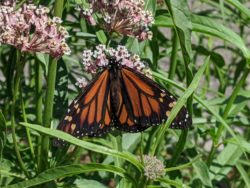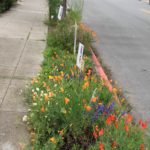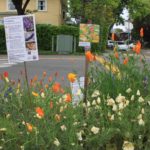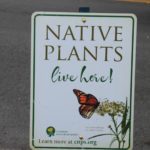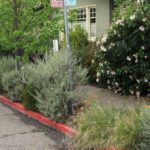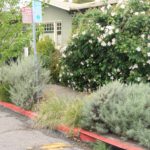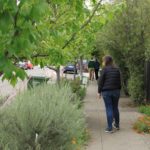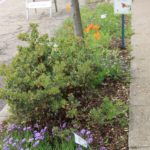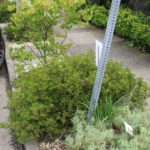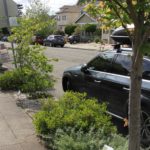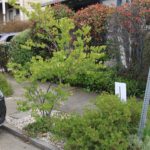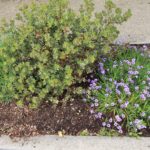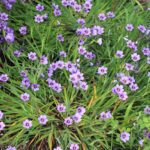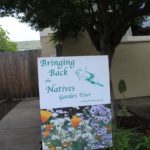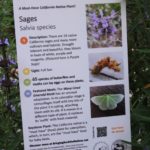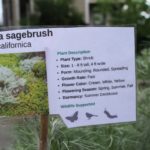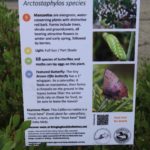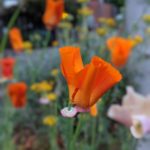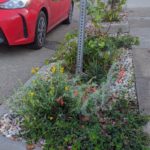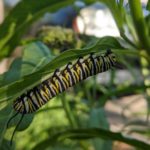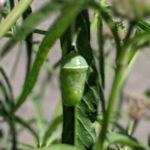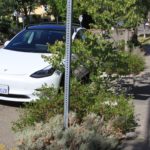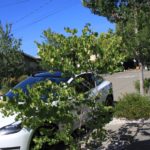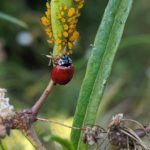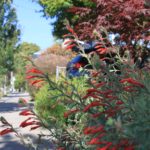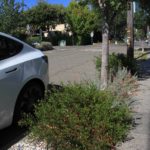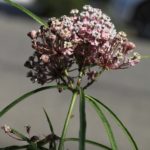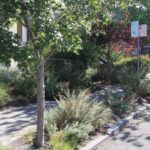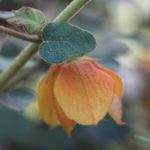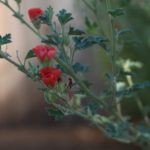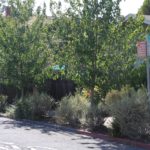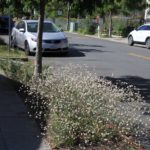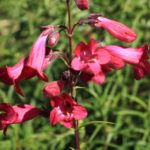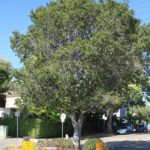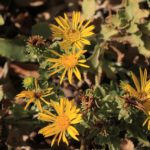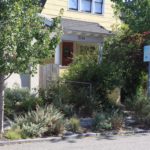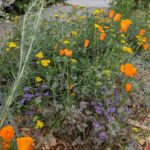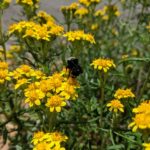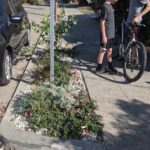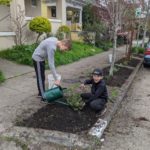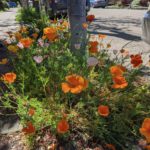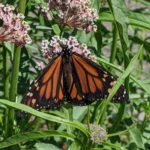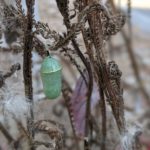Lot size: 1 traffic circle 20’ in diameter; 7 parking strips, ranging in size from 20' to 80' long x 3’ wide and totaling 200 running feet, 100% native; one front garden is 400 sq. ft.; the adjacent front garden is 250 sq. ft.
Garden Age: The oak in the traffic circle was planted in 2005; the rest of the Pollinator Pathway was installed in stages between 2019 and 2023
Years on the Bringing Back the Natives Garden Tour: 2
Showcase Feature
It was a desire to recreate lost habitats of the East Bay—the wildflower meadows, grasslands, and oak savannas that existed here hundreds of years ago—and to provide food, shelter and nesting areas for the wildlife that depend upon native plants for food, shelter, and nesting areas—that started this project.
Rewilding the neighborhood started in 2005, when neighbors planted a coast live oak seedling and native plants, such as gumplant, manzanita, California lilac, and fuchsia, in the traffic circle at Russell and Fulton in Berkeley.
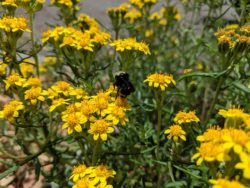 It continued 14 years later when tweens Leo and Joey Grossinger removed the scruffy lawn in the parking strip across the street from their house (at 2146), replacing it with manzanita, California sagebrush, Douglas iris, ceanothus, blue-eyed grass, and buckwheat. Curious and interested neighbors appreciated the improvement, asked what was happening, offered their parking strips and paid for the plants, and the boys planted natives in their neighbor’s parking strips, also.
It continued 14 years later when tweens Leo and Joey Grossinger removed the scruffy lawn in the parking strip across the street from their house (at 2146), replacing it with manzanita, California sagebrush, Douglas iris, ceanothus, blue-eyed grass, and buckwheat. Curious and interested neighbors appreciated the improvement, asked what was happening, offered their parking strips and paid for the plants, and the boys planted natives in their neighbor’s parking strips, also.
The Grossingers’ front garden includes blue-eyed grass, yarrow, and lemonade berry in the former driveway, while Toyon and hollyleaf cherry create privacy screens between the street and adjacent houses. The Grossingers’ nextdoor neighbor’s front garden, at 2150, contains California lilac, coffeeberry, flannelbush, and a low-growing manzanita that functions as a groundcover, with sweetly-scented yerba buena in the shade.
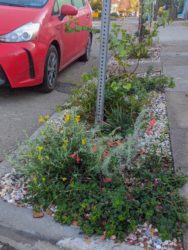 Knowing that there is a remarkable increase in wildlife when native plant cover increases to at least 70% of an area, and that the habitat is still more valuable with patches or drifts of the same plant (as opposed to just one of this and one of that), the parking strips were designed to contain multiple plants of the same type. Spreading California lilac and manzanita ground covers mingle with clusters of lupines, red-flowering buckwheat, Cleveland sage, blue-eyed grass, and fuchsia.
Knowing that there is a remarkable increase in wildlife when native plant cover increases to at least 70% of an area, and that the habitat is still more valuable with patches or drifts of the same plant (as opposed to just one of this and one of that), the parking strips were designed to contain multiple plants of the same type. Spreading California lilac and manzanita ground covers mingle with clusters of lupines, red-flowering buckwheat, Cleveland sage, blue-eyed grass, and fuchsia.
Together the Russell and Fulton Street plantings add up to create more valuable habitat than each house could create on its own. The resulting pollinator path has benefitted not only birds, bees, and butterflies, but also people, as neighbors have gotten to know each other better through this project, sharing seedlings, tools, and lemons. They have also worked together to place bulk orders for plants and mulch. The parking strip project has spread throughout the neighborhood, leading some neighbors to include native plants in their front and back gardens, as well.
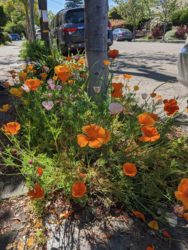 Your own garden can help bring back some of the lost landscapes in your city! Why not take a “Marie Kondo” look at the non-native plants in your garden; if you don’t love them, consider replacing them with native plants that will make a difference to the birds, butterflies, bees, and moths that are depending on all of us to include the plants in our gardens that they need to survive. What you plant makes a difference!
Your own garden can help bring back some of the lost landscapes in your city! Why not take a “Marie Kondo” look at the non-native plants in your garden; if you don’t love them, consider replacing them with native plants that will make a difference to the birds, butterflies, bees, and moths that are depending on all of us to include the plants in our gardens that they need to survive. What you plant makes a difference!
Other Garden Attractions (and Tips for Gardening for Wildlife)
• Gaps in the sidewalk strip plantings were provided to allow passengers to enter and exit their cars.
• Lights are one of the main drivers of insect decline; you can help by shielding your lights, so they shine down, not up (look for Dark Skies at Night-approved light fixtures—you can buy these at Home Depot); using motion sensors instead of leaving lights on all night; installing yellow bulbs, which are less harmful to wildlife then white or bluish lights, and drawing your blinds after dark. Ask about the bug-friendly bulb on the porch at 2146.
• Leave the leaves in your garden as the young of many moths and butterflies spend the winter sheltering in leaf litter.
• Eliminate pesticide use; rejoice when you see bugs are using the plants in your garden; they’re supposed to!
Gardening for Wildlife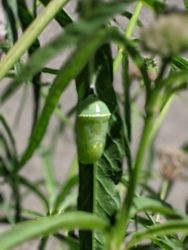
In the 1990s more than a million monarchs overwintered in forested groves on the California coast. Now, only a fraction of the population remains—a decline of more than 99% has been seen in California, and the International Union for Conservation of Nature has listed the Western monarch as endanger of extinction. But here in these Berkeley parking strips and gardens monarch butterflies flutter about, sipping nectar before laying eggs on milkweed—the only plant they can reproduce on. In late spring through early summer their yellow, black, and white banded caterpillars can be seen noshing happily on the narrow leaf milkweed leaves. In summer, the sharp-eyed among us might be able to spot the chrysalis of the monarch—bright green, with an amazing gold band, attached with a silk pad to a branch, which can be some distance from the milkweed patch.
Skippers and other butterflies are drawn to the clusters of blossoms on the red flowering buckwheat. Bumblebees roll like puppies in the poppies and gather pollen from lupines and California lilacs. Hummingbirds are attracted to the long, tubular flowers of the California fuchsia.
The plants in this project were chosen for their ability to support native butterflies and bees, and for also for their durability in a busy, urban setting.
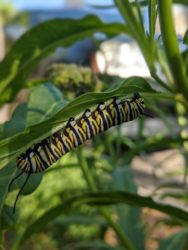 The plants in this project were chosen for their ability to support native butterflies and bees, and for also for their durability in a busy, urban setting.
The plants in this project were chosen for their ability to support native butterflies and bees, and for also for their durability in a busy, urban setting.
Keystone species in the Pollinator Pathway (watch this talk by Doug Tallamy!) Keystone species—our own, local ecological powerhouse plants — in the Pollinator Pathway include coast live oak, holly leaf cherry, California lilac, manzanita, redbud, lupine, sage, buckwheat, and penstemon.


